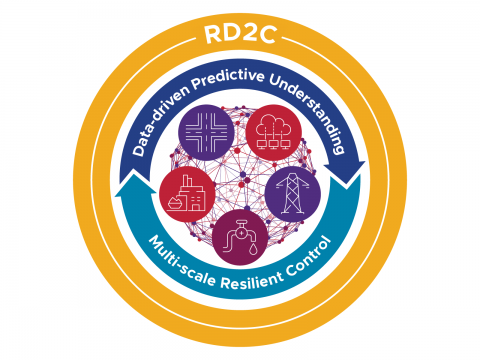The Multiplier Effect
Researchers win “best paper” for work to create much-needed data that can help advance cybersecurity solutions for critical infrastructure

Aditya Ashok, electrical engineer, and Thomas Edgar, cybersecurity researcher
(Photos by Andrea Starr | Pacific Northwest National Laboratory)
Researchers working to protect the power grid and other critical infrastructure from cyberattacks need rich scientific data to understand how critical infrastructure operational systems behave when under assault. This type of data, however, isn’t easy to come by. Critical infrastructure cybersecurity events are rare and infrequent. And simulating these threats requires specialized expertise and technology.
Two Pacific Northwest National Laboratory (PNNL) researchers led a project to address this challenge. Using PNNL’s cybersecurity and power grid experimental testbeds, Aditya Ashok and Thomas Edgar ran a series of experiments to model, observe, and analyze what happens when electric and natural gas distribution systems come under real-life cyberattack. Their work resulted in a previously unavailable dataset that can be used by other researchers who are working to secure critical systems.
“It’s the multiplier effect,” Edgar said. “By using our capabilities here at PNNL that others don’t have, we created a high-fidelity dataset around critical infrastructure that other researchers can use to build better cybersecurity solutions.”
The researchers’ paper documenting the experiments and resulting dataset won the “Best Conference Paper Award” at the 2021 IEEE International Symposium on Technologies for Homeland Security in November. The virtual symposium brought together leaders in academia, industry, and government to discuss critical infrastructure security.

Ashok and Edgar’s paper is titled, “A High-Fidelity Cyber-Physical Testbed-Based Benchmarking Dataset for Testing Operational Technology Specific Intrusion Detection Systems.” The study is one of several projects funded by PNNL’s Resilience through Data-Driven, Intelligently Designed Control (RD2C) Initiative.
Launched in 2021, RD2C is a Laboratory Directed Research and Development initiative that aims to (1) generate rich datasets, such as Ashok and Edgar’s, that provide a deeper understanding of cyber-physical systems under adverse conditions, and through this understanding, (2) develop novel sensing and control approaches that will improve critical infrastructure resilience.
“We want to drive the industry and academia forward because we’re feeding datasets everyone can use,” Edgar said.